
Enhance your organization’s security infrastructure with robust two-factor authentication (2FA), a critical component of multi-factor authentication (MFA) strategies. 2FA bolsters access security by requiring users to present a combination of two distinct identification factors. This dual-layer defense mechanism significantly mitigates the risk of unauthorized access through phishing, social engineering, and brute-force attacks, leveraging weak or stolen credentials.
By integrating a second factor, such as FIDO-based authentication methods, 2FA ensures an added layer of security during the login process. This approach combines something the user knows, like their login credentials, with something the user possesses, such as a verification code from an authentication app on their smartphone.
Implementing FIDO-based 2FA across your enterprise can be a swift and efficient process with the right solutions, providing your organization with the tools to defend against increasingly sophisticated threats in today’s digital landscape. Secfense enables seamless and scalable introduction of 2FA across your systems without requiring any code changes, ensuring a smooth integration into your existing IT environment.
Two-factor authentication (2FA) represents a pivotal advancement in securing online identities and accounts. Unlike one-factor authentication, which relies on a singular username and password, 2FA introduces a necessary second verification step. By requiring something the user knows (like a password) combined with something they possess (such as a security token, biometric verification, or a one-time code from an authentication app), 2FA significantly decreases the likelihood of unauthorized access, even if passwords are exposed. The modern digital landscape demands robust security measures, and that’s where two-factor authentication stands out. It’s not just an additional hurdle for cyber attackers; it’s a vital enhancement in user identification and account security, raising the bar for digital protection.
Today’s enterprises are rapidly embracing two-factor authentication, with a noticeable shift towards FIDO-based authentication for its superior security benefits. As the industry moves away from traditional 2FA methods, such as SMS, TOTP, and push notifications, FIDO authentication emerges as the frontrunner, offering unparalleled security by eliminating the vulnerabilities associated with other methods. The significance of 2FA cannot be overstated—it’s an essential defense mechanism against the prevalent issues of compromised passwords, sophisticated phishing attempts, and credential theft. By adopting 2FA, users and organizations alike can drastically minimize the dangers associated with password reliance, securing their digital assets against the increasing threat landscape. On the Secfense website, we underscore the importance of seamless integration. With our solutions, businesses can adopt FIDO-based 2FA effortlessly, without the need for extensive code changes, and can scale across the entire organization, streamlining the shift to a more secure authentication process.
Two-factor authentication (2FA) stands as an essential safeguard for organizations, vital for protecting against phishing and credential theft. Yet, its adoption has often been slowed by high costs, lengthy implementation processes, and issues with integrating into complex legacy systems. Secfense addresses these challenges head-on with the User Access Security Broker (UASB), a pioneering solution that simplifies the integration of 2FA.
The Secfense UASB facilitates a seamless and expedited adoption of 2FA, rendering it accessible, cost-effective, and efficient for organizations of any size. With the UASB, security administrators can effortlessly implement any 2FA method on the market into any web application without custom development. This deployment is not only swift—achievable in mere minutes—but also scalable across all company applications. Leveraging a virtual appliance setup, the UASB employs reverse-proxy traffic and learning mechanisms to analyze and understand user behavior, enabling automatic 2FA prompts when necessary.
Secfense champions the widespread implementation of 2FA, eradicating traditional barriers. With our approach, organizations can achieve comprehensive FIDO-based protection across all applications and users swiftly, ensuring robust security is in place within days.
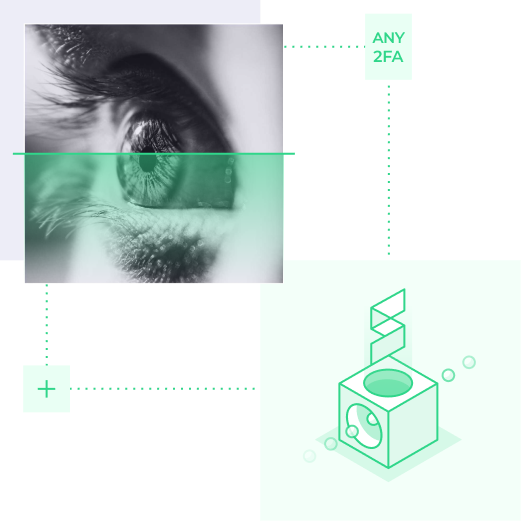
Secfense User Access Security Broker (UASB) champions the flexibility of two-factor authentication (2FA), providing organizations with a method-agnostic platform that accommodates a vast array of 2FA mechanisms. This versatility ensures that the Secfense UASB can integrate any 2FA option available, aligning perfectly with each organization’s distinct security requirements.
At the forefront of Secfense’s offerings is the recommendation of FIDO2 standards, a frontrunner in web authentication heralded for its superior defense against phishing and enhanced user-friendly experience. However, recognizing that different organizations have varied needs, Secfense UASB also extends support for traditional 2FA methods, including SMS-based authentication and Time-based One-Time Passwords (TOTP) utilized by various authentication apps.
Secfense empowers organizations to select the optimal 2FA method that resonates with their security imperatives and user preferences, providing an all-encompassing, flexible authentication ecosystem. The UASB live demonstration, which takes less than 15 minutes, offers a glimpse into the solution’s capabilities, while a comprehensive proof of concept (POC) can be conducted in under a week. Post-POC, clients gain a thorough understanding of how Secfense technology can fortify their entire digital infrastructure with 2FA, all without necessitating any software integration, paving the way for a seamless transition to advanced security measures.
Scaling 2FA with Secfense Across Business Sizes
Secfense User Access Security Broker (UASB) provides the most streamlined path for organizations of all scales to adopt two-factor authentication (2FA). Tailored to be both accessible and affordable, the Secfense UASB brings robust 2FA protection within easy reach for enterprises and small businesses alike, irrespective of the scope of applications requiring secure access.
For organizations ranging from niche startups to expansive multinational corporations, the Secfense UASB maintains a consistent deployment process. This uniform approach eliminates complexity and ensures scalability, allowing for a straightforward expansion of 2FA across any number of applications and user bases.
Seamless 2FA Integration for Diverse Environments
The advantage of Secfense UASB is particularly evident in large, diverse organizations where integrating 2FA can be a complex challenge due to vendor-specific constraints or maintenance hurdles. Secfense transcends these challenges, offering a universal solution compatible with any web application. This replicable deployment process allows for a cohesive 2FA implementation strategy, bolstering security and reducing the risk of data breaches across the entire digital environment.
By leveraging Secfense UASB, companies can effortlessly integrate 2FA, bypassing the convoluted setups and intricate integrations often associated with traditional methods. Whether catering to a small business or a large enterprise, the UASB scales to meet the needs of any organizational size.
Competitive Edge with FIDO-based Authentication
Organizations utilizing Secfense UASB can gain a competitive advantage over those still reliant on mere password defenses or outdated 2FA methods. In the current landscape where sophisticated cyber threats are ever-evolving, only FIDO-based authentication provides the robust defense required. With Secfense, adding FIDO authentication to applications takes just minutes, empowering organizations to become FIDO-protected rapidly and efficiently, often within days.
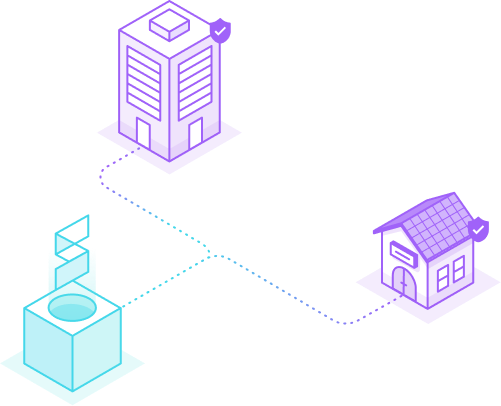
Understanding Authentication Factors in 2FA
The concept of “the Factor” in Two-Factor Authentication (2FA) refers to the distinct methods a user must employ to verify their identity. As a subset of Multi-Factor Authentication (MFA), 2FA demands two unique factors for user validation. A user might be prompted to present various combinations of authentication factors, which include knowledge-based factors like passwords, possession factors such as security tokens or smartphones, inherence factors including biometric identifiers, location-based factors verified by geolocation, and behavior factors that recognize user-specific actions. By incorporating multiple factors, both 2FA and MFA provide additional security layers, ensuring that only verified users gain access to sensitive systems and data. The modern trajectory in authentication is moving towards discarding passwords and traditional 2FA methodologies in favor of FIDO-based authentication, enhancing security significantly.
The Future of Online Security with FIDO2
FIDO2 stands at the forefront of online security, akin to an advanced lock system for digital accounts. This authentication standard revolutionizes the way login credentials are protected, preventing malicious actors from intercepting or stealing sensitive information. FIDO2 differentiates itself by keeping user credentials hidden and never shared, which drastically reduces the potential for phishing and hacking incidents. It engages users directly in the authentication process via specialized devices, adding a layer of active participation that thwarts unauthorized access. FIDO2 is akin to a fortified, user-exclusive lock, offering unparalleled protection in the digital world, and positioning itself as the future of secure, passwordless authentication. With Secfense, adopting FIDO2 is streamlined, safeguarding your online presence from sophisticated cyber threats.
The Role of Inherence Factors in Authentication
Inherence factors form a crucial element of authentication, utilizing the unique biological characteristics intrinsic to an individual. These factors—biometric identifiers such as fingerprints, facial recognition, iris scans, and voice patterns—are inherently personal and cannot be replicated or shared, making them an ideal proof of identity.
Secfense advocates for the implementation of Fast Identity Online (FIDO) standards, which leverage these inherence factors to authenticate users. FIDO’s approach to identity verification is to compare the presented biometric data with pre-registered information, ensuring the person attempting to access an account is the legitimate user. This method is not only highly secure but also user-friendly, streamlining the login process while significantly enhancing account security.
Enhancing Security with FIDO Inherence Authentication
FIDO protocols utilize inherence factors to elevate the security of user logins, harnessing unique personal attributes for verification. This advanced form of authentication ensures that access is granted only to the rightful owner of an account, effectively safeguarding against unauthorized entry. With Secfense, adopting FIDO’s authentication strategies, including inherence factors, is a straightforward process that strengthens the security infrastructure without complicating the user experience.
By integrating FIDO’s inherence-based authentication, Secfense offers a future-proof solution to online security challenges. This technology is a cornerstone of the move towards a passwordless future, reducing the reliance on knowledge-based factors that can be compromised, and instead, embracing the untapped potential of what makes each user unique.
Understanding the Knowledge Factor in Authentication
The knowledge factor in authentication relies on information that is meant to be known exclusively by the user. This typically includes passwords, which are sequences of characters, numbers, and symbols that should remain confidential between the user and the system. The fundamental rule for passwords is absolute secrecy; they must never be disclosed to others, ensuring that only the intended user can access their accounts.
However, the reliance on passwords alone presents significant security risks. They are often vulnerable to being guessed, stolen, or hacked, particularly if users opt for weak or common passwords like “123456” or easily deducible personal information. The tendency to reuse passwords across various platforms further exacerbates the risk, potentially leading to widespread security breaches from a single compromised password. Attackers employ methods such as brute force or phishing to acquire passwords, highlighting the insufficiency of the knowledge factor as the sole line of defense.
The Limitations of Passwords and the Need for Enhanced Security
Passwords, while common, are a flawed security mechanism due to their susceptibility to cyber threats. Many users inadvertently compromise their safety by choosing weak passwords or recycling them across multiple accounts, which hackers can exploit with relative ease. Sophisticated cyber-attacks such as brute force or phishing schemes are specifically designed to capture these knowledge factors, underlining the critical need for additional protective measures.
To mitigate these vulnerabilities, it is essential to supplement passwords with more robust security layers. This is where Secfense steps in, advocating for and facilitating the adoption of multi-factor authentication (MFA) and FIDO standards. By combining knowledge factors with other authentication methods such as biometrics or possession factors, Secfense helps organizations fortify their defenses, making unauthorized access exponentially more challenging for attackers. This comprehensive approach to security is a pivotal step in transitioning towards a more secure and passwordless future.
Leveraging the Location Factor in Authentication
The location factor is an authentication measure that validates a user’s identity by verifying their geographical location. It typically utilizes the IP address to determine the user’s current whereabouts. If a user has consistently accessed an application from a specific country and a login attempt is suddenly made from a different geographic location, the system recognizes this anomaly. This triggers the location factor security protocol, prompting the user to provide additional verification to confirm their identity. Such measures are crucial for preventing unauthorized access, as they add an extra layer of security when there’s a deviation from the user’s typical login behavior.
Enhancing Security with Geolocation Verification
Utilizing geolocation as a security measure can significantly enhance the protection of user accounts. It serves as a proactive barrier against potential intrusions, particularly when an access attempt is made from an unfamiliar location. This form of verification ensures that even if a user’s credentials have been compromised, the likelihood of a successful unauthorized login is reduced. With Secfense, the integration of location factor authentication is a straightforward process, adding to the suite of security protocols that safeguard user data. By adopting this method, organizations can better secure their digital environments against unauthorized access attempts from around the globe.
Implementing the Time Factor in Multi-Factor Authentication
The time factor plays a pivotal role in Multi-Factor Authentication (MFA) by incorporating the dimension of time into security protocols. This element restricts access to a system or online resource to certain pre-determined timeframes, usually aligned with a user’s expected behavior patterns. For instance, a system may be configured to expect an employee’s login during standard business hours. Attempts to access the system outside of these established hours would be flagged, prompting additional verification procedures. This control mechanism is particularly effective in preventing unauthorized access, ensuring that logins occur during periods that are deemed normal for the user, thus providing a temporal checkpoint for security.
Time-Based Authentication: A Crucial Security Layer
Incorporating the time factor into an organization’s MFA strategy adds a critical layer of defense, making it an effective tool against compromised credentials. By defining and enforcing acceptable login periods, organizations can automatically add an authentication challenge during atypical access times, which could indicate a potential security breach. This proactive measure adds depth to security practices, complementing other factors like knowledge, possession, and inherence.
Secfense integrates the time factor seamlessly into its MFA solutions, reinforcing the security of user logins with minimal impact on the user experience. By leveraging the time factor, organizations can further strengthen their security posture, limiting the windows of opportunity for unauthorized access and aligning authentication measures with user activity patterns.
Enhancing Security with Possession Factors in MFA
Possession factors have become a cornerstone in the realm of Multi-Factor Authentication (MFA), offering a tangible layer of security that complements the traditional password. These factors rely on physical items that an individual must have in their possession to gain access to a system or account. Modern examples include:
Possession factors greatly increase security by ensuring that only those with the authorized device can access an account, thereby significantly reducing the risk of unauthorized entry.
Secfense’s Integration of Possession Factors
Secfense User Access Security Broker facilitates the integration of any market-available possession factors, streamlining their connection to applications swiftly and effortlessly. With this solution, organizations can enhance their security infrastructure by adopting the latest possession-based authentication methods without the usual complexity. The Secfense broker simplifies the process, enabling a quick and efficient setup that allows businesses to deploy robust MFA with the possession factors of their choice, ensuring only verified users can access their critical systems and data.
FIDO-based Two-Factor Authentication (2FA) is a robust solution designed to mitigate a range of cybersecurity issues, effectively enhancing online protection. Key problems addressed by FIDO-based 2FA include:
Organizations are increasingly turning to FIDO-based 2FA as it presents the most effective defense against sophisticated phishing attacks and various forms of social engineering. Opting for Secfense to implement FIDO-based 2FA offers distinct advantages:
By choosing Secfense, companies can quickly enhance their security posture with FIDO-based 2FA, protecting against the ever-evolving landscape of cyber threats.
Phishing remains a prevalent tactic for cybercriminals, involving deceptive emails that lead users to malicious websites, potentially resulting in stolen passwords. Two-factor authentication (2FA) serves as an effective countermeasure by introducing a secondary verification step after the password has been entered, adding a significant barrier against unauthorized access.
Keylogging, where malware records every keystroke, is another method attackers use to capture passwords. The additional layer provided by 2FA ensures that even if a password is recorded, the rightful user must still authenticate through another method, thwarting unauthorized logins.
Brute-force attacks, which methodically test password combinations, are nullified by FIDO2’s approach. By requiring a physical device or biometric data for access, FIDO2’s protocol makes it virtually impossible for attackers to gain access through password guessing alone.
Modern 2FA, especially when incorporating FIDO standards, is an advanced safeguard for both individuals and organizations. By adopting FIDO-based 2FA, organizations can ensure that even if a password is compromised, the authentication process remains secure, as it does not solely depend on shared secrets.
Organizations are increasingly adopting FIDO-based 2FA to bolster or even substitute password-based security, adding additional authentication factors to the login process. Secfense is leading this transformation by offering a quick, easy, and cost-effective deployment of a 2FA security layer across all applications within an organization, emphasizing its commitment to enhanced, accessible cybersecurity.
Two-factor authentication (2FA) comes in various forms, and the User Access Security Broker by Secfense empowers organizations to implement and scale any 2FA method available in the cybersecurity market. This flexibility is central to the philosophy of a user access broker, providing security administrators with the autonomy to select the most suitable 2FA method for different user groups within their organization.
Secfense champions the adoption of the FIDO2 standard, advocating for its unparalleled security strength in the realm of authentication. While a myriad of 2FA options exists, Secfense positions itself as a neutral broker, streamlining the deployment process uniformly across all 2FA solutions. This approach ensures that regardless of the chosen method, the integration experience remains consistent, allowing organizations to fortify their security defenses effectively and efficiently.
By promoting FIDO2 and passwordless authentication, Secfense leads the charge toward a future where robust security and user convenience converge, offering the fastest and easiest way to deploy a secure, scalable 2FA layer across all enterprise applications.

One of the traditional, no longer recommended approaches to authentication is SMS-based authentication. It verifies the person’s identity by sending a text message with a special code to the mobile device of that specific person. The person needs to then type in the received code into the website or application in order to authenticate and access it.
Simplicity. SMS 2FA is one of the oldest and most commonly known 2FA methods. It simply sends a code to a person’s mobile phone. The code is entered and the access to the information is gained.
Speed. If something suspicious takes place, SMS-based 2FA sends a one-time password (OTP) to a person’s device, so only the person that physically has this device in his or her hands can log in and authenticate. SMS-based two-factor authentication is a fast way to verify the identity of a person.
Universality. SMS-based 2FA is the oldest form of multi authentication, so it has become
a commonly used security tool.
Connectivity requirement. SMS-based 2FA requires a smartphone with a reception. SMS-based 2FA has been compromised by various attacks, including SIM swapping, interception of SMS messages, and phishing attacks.
Since phone numbers aren’t tied to physical devices, it’s possible for hackers to outsmart this authentication method without accessing a person’s smartphone.
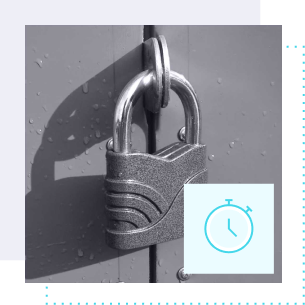
Another traditional 2FA method is Time-Based One Time Password (TOTP). This method generates a 2fa code on the device. The security key usually has the form of a QR code that the person then scans with his or her mobile device to generate a shortcode. The person then types the code into the website or application and gains access. The shortcodes generated by the authenticator usually expire within some minutes or even seconds. If the code is expired a new code is generated right after so the user needs to type in the right code within some specific time limit (that’s where Time-Based comes from).
Flexibility. This type of Two-Factor Authentication is more convenient than SMS-based 2FA because it can be used across multiple devices and platforms. SMS-based 2FA is restricted to devices that can receive the message from the operator.
Easy Access. Mobile authenticators do not require a person to be connected to the network. They remember which accounts a person is trying to access and can generate a new one-time password at any time, even if they are not connected to the internet.
Dependent on devices. TOTP based 2FA requires the person to have a device that can read the QR code to verify their identity. If a device is lost, runs out of battery, or gets “desync-ed” from the service, a person will lose access to information forever.
Can be compromised. It’s possible for a cybercriminal to clone the secret key and generate his or her own secret codes.
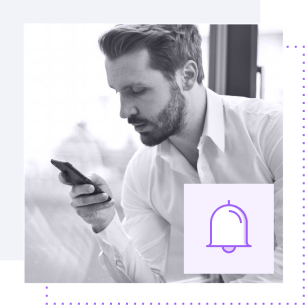
Push-based 2FA is a slightly improved approach to SMS and TOTP based 2FA. Push-based 2FA adds additional layers of security by adding other factors of authentication that previous methods couldn’t.
Increased Phishing Protection. The previous two types of two-factor authentication are susceptible to phishing attacks, however push-based 2FA replaces text codes with push notifications which adds an extra layer of security and helps prevent phishing attacks. When a person attempts to access his or her data, a push notification is sent to that person’s mobile phone. The push notification includes various information including location, time, and IP address of the machine on which the login attempt took place. The person needs to physically confirm on his or her mobile device that the info is correct and therefore verify the authentication attempt.
Easy. Push-based 2FA streamlines the authentication process because there are no extra codes that a person needs to receive and then type in. If a person sees that the push notification carries the correct information, then he or she simply accepts that login attempt and pushes a button to confirm. Then the access is granted.
Connectivity requirement. Similar to SMS-based 2FA in a Push-based 2FA data network is still necessary because the push is sent to a mobile device through a network. Therefore a person needs to be connected to the internet in order to use this 2FA functionality.
Security Awareness. The person that receives Push-based notification needs to be security-aware to be able to recognize if the login pattern looks suspicious or not. When the person doesn’t pay attention to the received message he or she can approve the malicious request and confirm the false IP address or login location. This method has been compromised by an attack called MFA bombing or MFA fatigue.

U2F security keys use a physical USB port to verify the location and identity of a person that attempts to access some specific website or application. A user inserts the U2F key into his or her device and pushes the button located on the U2F device. Once the key is activated, the person needs to type the PIN code and successfully authenticates it within the website or the app
Phishing protection. Since there is an actual physical intervention required (a person needs to press, insert, and enter a code into the token), the U2F key protects a person’s device from being phished.
Backup devices and codes. U2F keys can and should be backed up across multiple devices. This allows a person to replace his or her token whenever the other one is lost or broken.
Easy. U2F keys require simply to be entered to the USB port and pushed at the specific moment so they do not require any technical knowledge or skills.
Physical object. As a physical key, the U2F based 2FA is susceptible to being lost or damaged. If a key is lost and there’s no backup U2F key, then the access to the website or application is lost.
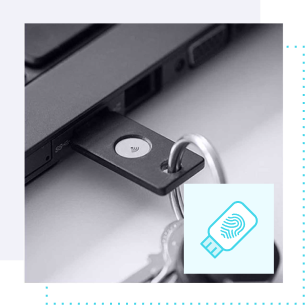
Built by the FIDO Alliance (Fast IDentity Online) and W3C (World Wide Web Consortium), the Web Authentication API (also known as FIDO2) is a specification that enables strong, public-key cryptography registration and authentication. WebAuthn makes it possible to take laptops and smartphones with built-in biometric technology and use them as local authenticators in an online authentication process.
Convenient. Any website, application, or browser that supports the FIDO2 standard together with a built-in biometric authenticator like TouchID can be used to enable a strong authentication mechanism. The FIDO2 standard is globally used by hundreds of technology brands including Google, Apple, Microsoft, Amazon, and many more.
Phishing resistant. FIDO2 is one of the safest Two-Factor Authentication methods available on the market. FIDO2 allows websites and online applications to trust biometric authentication as a credential that is specific only to that service — this means no more shared secret and therefore they can’t be stolen and exploited.
Complex account recovery. FIDO2 based 2FA makes the recovery process more complicated compared to previous 2FA methods. In SMS, TOTP, and Push-based 2FA there’s some form of the account recovery process that a security admin within the company can initiate. In the case of FIDO2 based 2FA, this process is way more difficult because it is always tied to the identity of a specific person. That’s why it is recommended to combine FIDO2 authenticators and for example, use laptop or smartphone biometric authentication but also keep some registered FIDO2 security keys in a safe in case the main device will get stolen or will break.
Strong FIDO-based two-factor authentication is becoming more popular across many industries. The type of business niche is not really important; as long as a user is accessing a website or an application that stores valuable data, there’s necessary to protect credentials and secure the authentication process.
User Access Security Broker from Secfense addresses cybersecurity risks primarily in big and medium-sized companies. All industries can benefit from Secfense UASB as long as they use web applications with login-restricted access.
Cybercriminals often target the healthcare sector because, unlike the banking, insurance, and capital markets or e-commerce industry, the healthcare cybersecurity budget is much smaller, and cybersecurity is much weaker.
Additionally, healthcare employees are among the least security-aware when it comes to cyber risks. That makes them more likely to fall victim to phishing attacks and social engineering. Implementing effective security policies is crucial as it can reduce the risk of a data breach. And one of the most effective ways to improve cybersecurity across the board is through additional microauthorizations.
The financial services industry was one of the pioneers of two-factor authentication due to the much bigger risk of hacking attempts in this particular sector. There are also various local and international regulations that require banks to use strong 2FA in order to protect their customers and employees. Some examples of these regulations are the PSD2 directive (Payment Service Direct 2), GDPR (General Data Protection Regulation), NIS2, or Digital Operational Resilience Act (DORA). Secfense designed microauthorizations to make the financial industry employee application journey almost untouched while at the same time substantially increasing the security level. Microauthorizations add additional authorization requirements within the application wherever it’s needed.

The digitalization trend is challenging government institutions to introduce changes to their infrastructure and slowly make a shift to cloud and mobile. Strong two-factor authentication increases the security of government institutions and allows them to step into a zero-trust security approach for both government officials as well as the citizens that access public sector applications. With such a great number of people using this technology, two step authentication needs to provide both security and ease of use.

The ecommerce sector is one of the industries that is tied by various security regulations and directives. The PSD2 is designed to create fair competition between the banking industry and modern payment service providers (PayPal, Google Wallet, Wepay, etc.). That means strong two-factor authentication for online purchases. E-commerce is the sector that has a lot to lose in case the security policies are not obliged due to GDPR regulation. In case of the breach, GDPR directive can lead e-commerce businesses to pay huge fines as compensation for not protecting well enough their customers’ private data.

Private schools and big universities became a popular target for phishing attacks and social engineering. More and more often cybercriminals attack organizations from the inside. In one of the cases of schools being compromised by data theft, it was a former IT official of the school who had been working for the institutions for many years.
These types of inside theft can be avoided with the use of microauthorizations from Secfense. This functionality makes it possible to stop the user when he or she reaches for some specific resources or wants to perform some specific actions in the protected application. Schools manage a big amount of sensitive user data such as financial status, health situation, etc. This data makes teaching institutions a great target for cyberattacks especially that (similarly to the healthcare industry), the security budget is usually very limited. Schools and universities usually reach for strong two-factor authentication to protect mobile devices and workstations of students and teachers. Protecting these devices with strong authentication mechanisms is usually the first step in order to maintain data security in educational institutions.

Due to the importance of functions that are relevant to the manufacturing sector, data on scale installations are needed. Two-factor authentication helps manufacturing companies have lingering operations through all applications and user accounts.
Securing company devices is securing the timely implementation of projects without security. Simple two-factor authentication helps the company to provide security also for device devices that want to access the service when we provide access to firewall services.
The infrastructure of large tech companies usually consists of hundreds or even thousands of applications. This makes many of them vulnerable to cyberattacks. Security departments must therefore ensure that all applications and access points are properly secured and protected against leakage of confidential data.
For large technology companies, Secfense has developed a solution that significantly improves the authentication security of all users, without the need to spend valuable programming resources on technology adoption. Thanks to the User Access Security Broker from Secfense, large technology companies can easily secure employees performing their duties in the office or at home and provide them with secure and effective authentication.
Security of client data is one of the key areas that organizations providing legal services must take care of. Secfense provides technology that allows law firms to focus on the essence of their business, freeing them from cybersecurity problems.
A number of directives and regulations oblige law firms and notary offices to ensure the privacy of their client’s data. User Access Security Broker by Secfense helps these types of companies easily and hassle-free to achieve security compliance and eliminate phishing threats.
Large energy companies usually have advanced technological infrastructure and many systems and applications that employees use on a daily basis. Hence, data security may be threatened by multiple cyberattack vectors.
User Access Security Broker by Secfense is a solution that enables energy and utility companies to leverage strong two-factor authentication for all employees on all applications they use.
All vendors and partners can also benefit from strong authentication.
User Access Security Broker by Secfense allows you to easily implement and scale strong two-factor authentication, allowing the security administrator in the company to decide which method will provide the most security and the greatest convenience.
Secfense enables airlines, hotels, travel companies and travel agents to secure access to employee and customer data and protect against identity theft and internet fraud.
The larger the travel and travel company, the greater the benefits Secfense offers.
Airlines, car rental companies, and hotels will gain the most, as the confidential user data they store most often become the focus of cybercriminals.
Loyalty programs that encourage customers to use systems and applications are gaining in popularity in the travel and travel industry. Increased customer internet activity increases the risk of an attack to steal data.
For organizations in the tourism and travel industry, it should therefore be important to ensure a high standard of data security and secure all access points through which a potential burglar may sneak into the company’s systems.
Social Engineering Thwarted by FIDO2 Authentication
Social engineering exploits human interactions to gain sensitive information. FIDO2’s authentication combats these tactics by requiring direct user involvement with hardware or biometric identifiers, thereby preventing deceitful practices from compromising security.